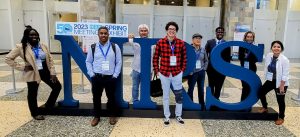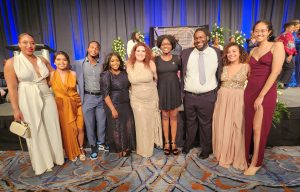
My current research is funded by the Partnerships for Research Education (PREM) at TSU-Fisk-University of Illinois at Urbana-Champaign and by the U54 Pilot Grant through the Meharry-Vanderbilt-TSU Cancer Partnership to end health disparities. I develop biomaterials for cancer immunotherapy under the guidance of Dr. Richard Mu at TSU, Dr. Todd Giorgio at Vanderbilt, and Dr. Anil Shanker at Meharry Medical College.
In 1976, Robert Langer and Judah Folkman developed polymers for the encapsulation of macromolecules like proteins inside of polymers to enable their sustained release. Today, I use similar polymers to make sustained-release microcapsules containing such macromolecules.
At their largest, these microcapsules should be one-tenth the diameter of a human hair. They should also be non-toxic, biodegradable, and have tunable sustained-release technology which allows for controlled protein drug-delivery over a dose-appropriate time period.
How does one fabricate such a microcapsule? Millions of them? There are a few ways. In my research, I specialize in developing one of the many possible techniques to achieve this, called electrohydrodynamic atomization or electrospray. It is important to me that the fabrication process of these microcapsules be eco-friendly and void of any toxic organic solvents, which is currently more prevalent in the literature than I’d expected, and that is my current research focus.
And how does one ensure they have indeed fabricated such a small microcapsule? To do so, it is necessary to have access to advanced characterization techniques and powerful microscopes like the ones at VINSE. I am grateful for Dr. James McBride and Dr. Dmitry Koktysh who kindly and patiently have helped me test and analyze my samples while helping me understand the underlying principles.
I have been invited to present this work at several institutional and national conferences, and I have received a poster award from PREM and my university, TSU, for my work. I have also presented this work as the first-ever student speaker and keynote at the Meharry-Vanderbilt-TSU Cancer Symposium last year.
My journey
I consider myself a semi-Nashville native. I believe I am considered an Ecuadorian-American woman. What does that really mean? I wasn’t sure I needed to know for most of my life, I just was. As I have grown and encountered persons with other identities, I have learned more about who I am.
To be Ecuadorian means that I grew up eating the best seafood and corn in the world. It also means that a generation prior, my parents lived in poverty and grew up working without shoes. I am so proud of them for the bravery to transplant our family tree to a new country. I would also like to say that immigrating to a new country isn’t just about coming because everything will be magically better here.
There are many things about Ecuador I would bring here because it is so beautiful. The snow-covered volcanoes, the ocean and islands, the hot springs, the rainforest. There is also my grandmother’s chair in a patio walking distance from a river to swim in. There are sacred cathedrals and hats handwoven by indigenous hands, here mistakenly known as Panama hats! There is delicious beans and rice, and unbelievable spices and herbs. It is not easy to say good-bye to all of this to breathe life into a dream, but with love it’s compelling. And my parents did that. My siblings and I did too, as young adults, or in my case, as a child, as our family immigrated to the beautiful city of Nashville, Tennessee.
I love Nashville because it meant I could go fishing with my uncles and play with my American cousins who I believed were, and presently still do, so cool. More specifically, I grew up in Madison, Tennessee. I attended Taylor Straton elementary school for my first year in Nashville. Then, I attended Neely’s Bend Middle School and Hunters Lane High School. As I think about my education, I find myself feeling humbled and grateful for all of my teachers. I’d especially like to mention my first teacher in Ecuador, Señorita Brigidita, who taught us with patience and grace and my very first American teacher, Mrs. Darlene Burnett, with whom I learned English, and those in the IB program, many who saw us from our first day as high school freshmen all the way through to graduation.
After graduating from high school as class Valedictorian, I began college at Middle Tennessee State University with a full-tuition scholarship. College was intellectually transformational for me – why hadn’t I been here sooner? One day, I spent the afternoon in the library selecting literature reviews from all topics of science and hit print. I believe each day brings a lesson and that day I learned other library attendees don’t like it when the only printer available is printing for 30 minutes straight. Oops.
I began college as a member of Scholars Academy, a retention initiative for students most at risk of dropping out led by Mr. Bandon Chapman, an army veteran and HBCU graduate. I didn’t really think I was at risk of dropping out, but I believe demographically I was. Through Scholars, I made my first friends in college and in Mr. Chapman found my first mentor. In Dr. Ryan Otter, I found my first mentor who was a scientist, a toxicologist to be more precise, who explained to me what research was and encouraged me to pursue a PhD.

While working towards achieving two Bachelors of Science degrees in Computer Science and Biochemistry, I participated in two Research Experience for Undergraduate (REU) programs funded by the National Science foundation. My first summer, I simulated the behavior of the serotonin-reuptake transporter, a protein involved in depression, anxiety, and addiction. The next summer, I worked on simulations of wound healing through computational models of cell migration at MIT. I am currently a PhD student at Tennessee State University in Engineering and Computational Science. During my time in graduate school, I have received the National Science Foundation Graduate Research Fellowship and have been selected as a Scientist Mentoring Diversity Program (SMDP) Scholar, where I have found even more mentors and champions for myself and peer mentors with big dreams like me, who have brown skin like me. During this time, I have also had the honor of meeting the person I believe will be my life-long partner, of finding a spiritual path, and have learned to love life for the journey it is.
Presently, I am blessed to be mentored by amazing women scientists and professionals whose experience and strength inspires me daily. I am also blessed to be mentored by my tias, whose hard work and solace in spirituality is an inspiration to me, too.

As I’ve reflected on my journey, I have learned that categories and self-identities are a topic worth celebrating openly, with the underlying agreement that all identities are unique and equal in value and contribution to what it means to be a human. I believe it is part of my calling to be a bridge towards helping make society more loving and celebratory of those previously and presently underserved. Aside from biomedicine and science, I am passionate about autism and neurodivergence and would one day love to work as a director for STEM education for neurodivergent individuals. I also believe we can never learn enough from our ancestors. As such, I also believe each day, we should honor the Indigenous as we stand on their ancestral land.
To step into myself has required persistence to pursue and attain a dream with patience and grace. As a result of my experiences, I have felt myself become proud to be a queer Latina.